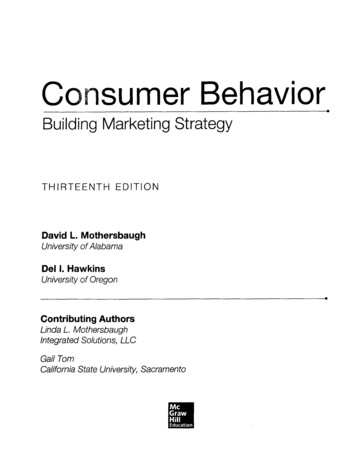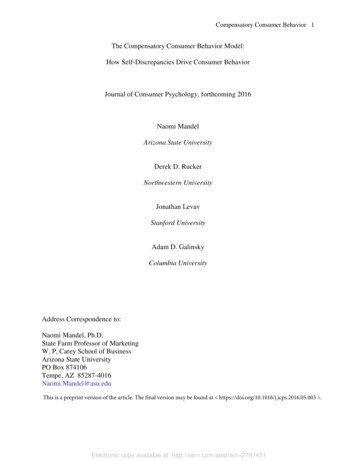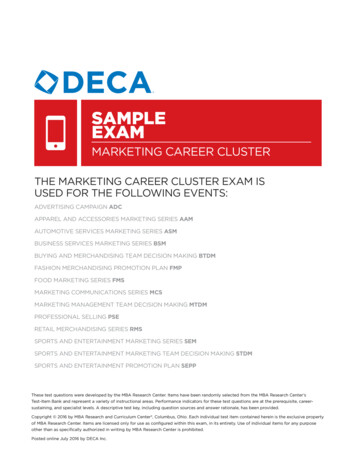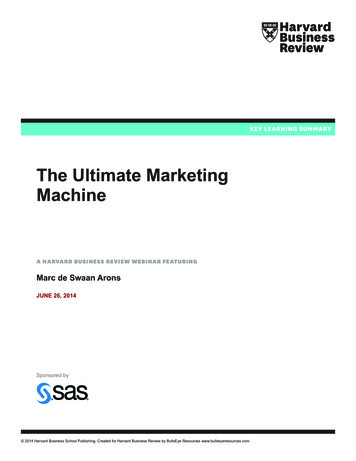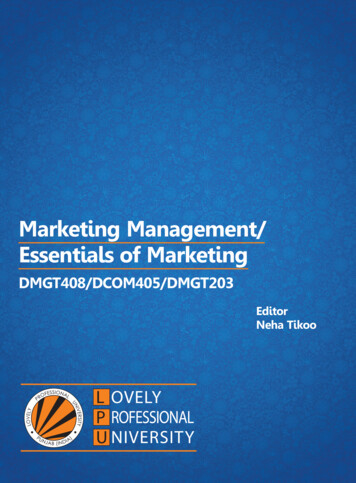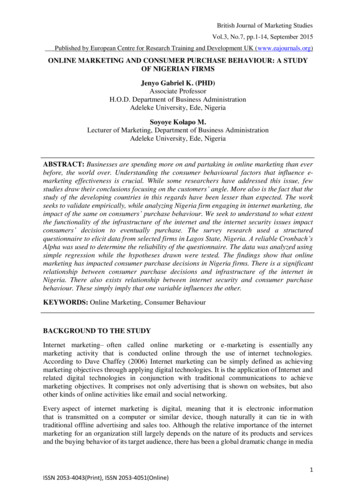
Transcription
British Journal of Marketing StudiesVol.3, No.7, pp.1-14, September 2015Published by European Centre for Research Training and Development UK (www.eajournals.org)ONLINE MARKETING AND CONSUMER PURCHASE BEHAVIOUR: A STUDYOF NIGERIAN FIRMSJenyo Gabriel K. (PHD)Associate ProfessorH.O.D. Department of Business AdministrationAdeleke University, Ede, NigeriaSoyoye Kolapo M.Lecturer of Marketing, Department of Business AdministrationAdeleke University, Ede, NigeriaABSTRACT: Businesses are spending more on and partaking in online marketing than everbefore, the world over. Understanding the consumer behavioural factors that influence emarketing effectiveness is crucial. While some researchers have addressed this issue, fewstudies draw their conclusions focusing on the customers’ angle. More also is the fact that thestudy of the developing countries in this regards have been lesser than expected. The workseeks to validate empirically, while analyzing Nigeria firm engaging in internet marketing, theimpact of the same on consumers’ purchase behaviour. We seek to understand to what extentthe functionality of the infrastructure of the internet and the internet security issues impactconsumers’ decision to eventually purchase. The survey research used a structuredquestionnaire to elicit data from selected firms in Lagos State, Nigeria. A reliable Cronbach’sAlpha was used to determine the reliability of the questionnaire. The data was analyzed usingsimple regression while the hypotheses drawn were tested. The findings show that onlinemarketing has impacted consumer purchase decisions in Nigeria firms. There is a significantrelationship between consumer purchase decisions and infrastructure of the internet inNigeria. There also exists relationship between internet security and consumer purchasebehaviour. These simply imply that one variable influences the other.KEYWORDS: Online Marketing, Consumer BehaviourBACKGROUND TO THE STUDYInternet marketing– often called online marketing or e-marketing is essentially anymarketing activity that is conducted online through the use of internet technologies.According to Dave Chaffey (2006) Internet marketing can be simply defined as achievingmarketing objectives through applying digital technologies. It is the application of Internet andrelated digital technologies in conjunction with traditional communications to achievemarketing objectives. It comprises not only advertising that is shown on websites, but alsoother kinds of online activities like email and social networking.Every aspect of internet marketing is digital, meaning that it is electronic informationthat is transmitted on a computer or similar device, though naturally it can tie in withtraditional offline advertising and sales too. Although the relative importance of the internetmarketing for an organization still largely depends on the nature of its products and servicesand the buying behavior of its target audience, there has been a global dramatic change in media1ISSN 2053-4043(Print), ISSN 2053-4051(Online)
British Journal of Marketing StudiesVol.3, No.7, pp.1-14, September 2015Published by European Centre for Research Training and Development UK (www.eajournals.org)consumption over the last 10 years towards digital media which means that the internet isbecoming important for all categories.Hence, the internet as a communication medium has broadened the scope of marketingcommunications considering the number of people who can be easily reached including thelocations where they are reached, for example, from desktops to mobile smart phones. It hasalso increased the richness of marketing communications by combining text, video, and audiocontent into rich messages. Thus, the web is arguably richer as a medium than some traditionalmediums such as the television because of the complexity of messages available, the enormouscontent accessible on a wide range of subjects and the ability of users to interactively controlthe experience (Laudon and Traver 2013).Furthermore, the Internet has succeeded in expanding the information intensity of the marketplace immensely by providing marketers and customers with well detailed real-timeinformation about consumers as they transact in the market. Consumers are much moreavailable to receive marketing messages due to the “always-on” environment created by mobiledevices which results to an extraordinary increase in marketing opportunities for firms (Laudonand Traver 2013).Having said the above, understanding the mechanisms of virtual shopping and the behavior ofthe online consumer is a priority issue for practitioners competing in the fast expanding virtualmarketplace. Given the continuous expansion of the internet in terms of user numbers,transaction volumes and business penetration, quite a lot of research has endeavor to uncovervarious technicalities involved.More than 20 per cent of Internet users in several countries already buy products and servicesonline (Taylor Nelson Sofres, 2002) while more than 50 per cent of US net users regularly buyonline (Forrester Research Inc, 2004). These developments are gradually transforming ecommerce into a mainstream business activity while at the same time, online consumers arematuring and virtual vendors realize the importance and urgency for a professional andcustomer-oriented approach. Yet the Internet meltdown at the end of the 1990s and plenty ofmore recent anecdotal and empirical evidences indicate that many online firms still do notcompletely understand the needs and behaviours of the online consumer (Lee, 2002) while theysell products online (Joines et al., 2003, p. 93).As in the case of traditional marketing in the past, most of the recent research and debate isfocused on the identification and analysis of factors that one way or another can influence oreven shape the online consumer’s behavior; a good deal of research effort is focused onmodeling the online buying and Decision-making process (Miles et al., 2000; Liu and Arnett,2000; Cockburn and McKenzie, 2001; Liao and Cheung, 2001; McKnight et al.,2002; Joineset al., 2003; O’Cass and Fenech, 2003).While many researchers do not see any fundamental differences between the traditional andonline buying behavior, it is often argued that a new step has been added to the online buyingprocess: the step of building trust or confidence (Lee, 2002; Liebermann and Stashevsky, 2002;McKnight et al., 2002; Suh and Han, 2002; Liang and Lai, 2002). An important contributionin classifying the increasingly growing number of research papers on the subject of the virtualcustomer’s behavior is the study of Cheung et al. (2005). The findings of their comprehensiveliterature review are summarized in a model depicting the main categories of factors affecting2ISSN 2053-4043(Print), ISSN 2053-4051(Online)
British Journal of Marketing StudiesVol.3, No.7, pp.1-14, September 2015Published by European Centre for Research Training and Development UK (www.eajournals.org)the online consumers. The study identifies two groups of uncontrollable factors – consumercharacteristics and environmental influences, as well as other groups of controllable ones.The Nigerian experiences in all these have been partially explored. Ayo et al (2011)surprisingly asserted that in spite of the growth rate of internet marketing, consumers still assessbusiness website only to source for information but yet make their purchases traditionally.Possible factors responsible for such behaviour like technology fit, trust and risk (securityissues), internet infrastructures were tested.On the other hand, the recent work of Chukwu and Uzoma (2014) provided scientific evidencesto show that Nigerian consumer patronize online retailers very significantly. One wonders whatis responsible for the noted changes. Furthermore, Husain and Adamu (2014) pointed out thatthe use of social media especially the facebook and twitter have been playing an important rolebut whether these have encouraged actual online purchases was not specifically stated.Objectives of StudyHaving noted that most of the research in this regards concentrated their studies from thecustomer perspective and few even study developing countries, a comprehensive focus onNigerian firms become imperative. The objective of this study is to while studying Nigerianfirms engaging in internet marketing, determine if online marketing impacts on consumerpurchase decisions in Nigeria. This will be done by examining; To what extent the functionality of the infrastructure of the internet impact consumerpurchase behaviour in Nigeria?To what extent the internet security issues impact consumer purchase decisions inNigerian firms.An understanding of this topic of study from the firm’s perspective will further enrich theliterature as researchers in their search for more information on the study of the impact ofonline-marketing in consumer purchase decision in Nigerian firms and other related subjectcan use this study as a reference point. This aids the further buildup of Nigerian firm’s onlineMarketing strategies to convert prospective customers into active ones. Further, through thestudy, the importance of the emergence of online marketing in Nigeria which provides adeveloping vision for marketers or firms is emphasized.Research Questions -Does online marketing impact consumer purchase decisions in Nigeria?-To what extent does the functionality of the infrastructure of the internet impactconsumer purchase behaviour in Nigeria? -How does the internet security issues influence consumer purchase decisions inNigerian firms?Research hypothesis:Ho :Online marketing has no impact on consumer purchase decision in Nigerian firms.H1:Online marketing has impact on consumer purchase decision in Nigerian firms.Ho :There is no relationship between the Consumers purchase decisions and thefunctionality of the infrastructures of the Internet.3ISSN 2053-4043(Print), ISSN 2053-4051(Online)
British Journal of Marketing StudiesVol.3, No.7, pp.1-14, September 2015Published by European Centre for Research Training and Development UK (www.eajournals.org)H1 :There is a relationship between the Consumers purchase decisions and the functionalityof the infrastructures of the Internet.Ho :There is no relationship between the Consumers purchase decisions and internetsecurityH1 :There is a relationship between the Consumers purchase decisions and internet securityLITERATURE REVIEWOnline marketing uses all facets of internet advertising to generate response from theprospected customers and owing to the wide use of internet in all dimensions of life, theprocurement in the first world countries mainly has been enhanced and now spreading to othercountries rapidly. One theme that has often received wide attention among researchers is thefactors that influence consumers to shop online. This helps in determining the success ofemerging online shopping habits of new breed of consumers.The current literature on consumer online purchase decisions has mainly concentrated onidentifying the factors that affect the willingness of consumers to engage in internet shopping.In the domain of consumer behaviour research, there are general models of buying behaviourthat depict the process which consumers use in making a purchase decision. These models arevery important to marketers as they have the ability to explain and predict consumers’ purchasebehaviour. The classic consumer purchase decision-making theory can be characterized as acontinuum extending from routine problem-solving behaviours, through to limited problemsolving behaviours and then towards extensive problem-solving behaviours (Schiffman et al.,2001).The traditional framework for analysis of the buyer decision process is a five-step model. Giventhe model, the consumer progresses firstly from a state of felt deprivation (problemrecognition), to the search for information on problem solutions. The information gatheredprovides the basis for the evaluation of alternatives. The development and comparison ofpurchase evaluation criteria result in the actual decision to buy. Finally, post-purchasebehaviour is critical in the marketing perspective, as it eventually affects consumers’ perceptionof satisfaction/dissatisfaction with the product/service (Wells et al.2000).This classic five stagemodel comprises the essence of consumer behaviour under most contexts. Nevertheless, themanagement of marketing issues at each stage in the virtual environment has to be resolved byindividual Internet-marketers. Decision sequences will be influenced by the starting point ofthe consumer, the relevant market structures and the characteristics of the product in question.Consumers' attitude towards online shopping is a prominent factor affecting actual buyingbehaviour. Jarvenpaa and Todd (1997) as revised by Lowengart and Tractinsky (2001)proposed a model of attitudes and buying intention towards Internet purchases in general. Themodel included several indicators, belonging to four major categories; the value of the product,the shopping experience, the quality of service offered by the website and the risk perceptionsof Internet retail shopping. In the research conducted by Vellido et al. (2000), nine factorsassociated with users' perception of online shopping were put forward. Among those factors,the risk perception of users was demonstrated to be the main discriminator between peoplebuying online and people not buying online. Other discriminating factors were; control and4ISSN 2053-4043(Print), ISSN 2053-4051(Online)
British Journal of Marketing StudiesVol.3, No.7, pp.1-14, September 2015Published by European Centre for Research Training and Development UK (www.eajournals.org)convenience of the shopping process, affordability of merchandise, customer service and easeof use of the shopping site.In another study, Jarvenpaa et al. (2000) tested a model of consumer attitude towards specificweb base stores in which perceptions of the store's reputation and size were assumed to affectconsumer trust of the retailer. The level of trust was positively related to the attitude towardsthe store and is inversely related to the perception of the risks involved in buying from thatstore. Jarvenpaa et al. (2000) concluded that the attitude and the risk perception affected theconsumer's intention to buy from the store. Consumers’ perceived risks associated with onlineshopping have a critical effect on their decision making.In addition to the impact of trust and perceived risks associated with online shopping,enjoyment of the online shopping experience is also an important determinant of retainingonline shoppers. (Cheung et al 2005). Many online purchasers have been said to ascertain thatthey would not shop on a particular website next time if they had an unpleasant experiencewith it. On the web, shopping enjoyment is positively and significantly related both to attitudesand intentions toward shopping on the web (Chaffey et al, 2012). Online shopping is, however,a different experience from shopping in a physical retail store. One major point of differencedeals with store atmospherics. As flow experience occurs during network navigation, an issueOnline-marketers must consider is whether consumers’ skills are competent to meet thechallenges of the virtual environment. Therefore, the best-designed information package willgenerate a competitive advantage.Information technology provides online consumers with tremendous access to informationabout products and services from anywhere in the world and from different sources other thansolely from the product seller. The combination of less time available for shopping, limitedinformation-processing capability and the explosive amount of information on the web has,however, led customers to demand more control, less effort and greater efficiency duringshopping (Belch et al, 2012). In order to respond to the customers’ desire for control andconvenience, web stores have to design an efficient system to enable consumers easily findwhat they need, learn more about it and quickly make a purchase decision (Chaffey and Smith,2008).Design characteristics of a web page were found to affect consumers’ online buying decision.Belch and Belch (2012) found that homepage presentation is a major antecedent of customersatisfaction. The other antecedents; such as logical support, technological characteristics,information characteristics and product characteristics; are also predictive factors tosatisfaction. Chaffey and Ellis-Chadwick (2012) investigated the factors which makecommercial web pages popular. They found that a high daily hit-rate is strongly influenced bythe number of updates made to the website in the preceding three month period. The numberof links to other websites was also found to attract visitor traffic. Providing a feedback sectionfor customers will lead to higher sales.In Koufaris et al. (2002)’s research, it was proposed that two types of information; non-valueadded and value-added; should be used by search mechanisms in web-based stores. Smith andWheeler (2002) also found that the existence of value-added information at a commercialwebsite can be an important incentive for people to shop online, and provides a key source ofdiversity. The explosive growth in usage of the Internet provides a great number of potentialconsumers to E-marketers. Whether or not marketers can convert their potential customers5ISSN 2053-4043(Print), ISSN 2053-4051(Online)
British Journal of Marketing StudiesVol.3, No.7, pp.1-14, September 2015Published by European Centre for Research Training and Development UK (www.eajournals.org)into real ones and retain them depends, to a very large extent, on the service they offer and onthe perceived customer satisfaction of consumers (Luarn and Lin 2003).The concept of customer satisfaction occupies a central position in marketing theory andpractice. Many researchers have found the quality of web retailing sites as a dominantantecedent of customer satisfaction within the online shopping environment. Assuming webdesign as an important issue in web shopping, Wolfinbarger and Gilly (2002) developed a fourdimensional scale; that included website design, Reliability/fulfillment, customer service andprivacy/security to measure the quality of an online retailing site. They found that websitedesign quality was an important issue in customer satisfaction. This scale was tested andvalidated, and they recommended its use in any further study dealing with the measurement ofonline quality.Lohse et al (2000) attempted using a Psychographic based study to provide an understandingof the characteristics of users various lifestyles that lead to online buying behavior. The surveyrevealed that the very important factors in predicting online buying behavior include:i)Looking for product information online,ii)Leading a “wired lifestyle"- this is when consumers spend relatively large amount of their time online, and wheniii)Recently ordering from a catalog.Reasons why consumers choose the online channel includes: 24-hour shopping convenience;the ease to compare prices; free shipping offers; no crowds like in mall/traditional stores; moreconvenient to shop online; easier to find items online than in stores; better variety online; nosales tax; direct shipping to gift recipients and the ease to compare products. Others are trustedseller status; No tax; online coupon availability; Return policy and Customer loyalty/rewardsprogram.The fact remains that firms of all sizes and from all industries have invested in Internetapplications and try to establish a net presence since people increasingly use the Internet tocheck out company or product information. The Nigerian firms have not lagged behind in thisbut whether the success rate is worthy of the budget expended on the web facilities remains asource of concern.METHODOLOGYFor the purpose of this research, primary data were sourced with the use of questionnaire. Thequestionnaire comprised close-ended questions only. The completed questionnaires weredrawn based on the research questions under study. These form the basis of the analysis.The population of the research includes some selected firms in Nigerian. From this population,samples of thirty (30) companies are drawn from Lagos metropolis to participate in the researchand one hundred and twenty (120) questionnaires are administered to them to draw conclusionand analysis from their responses. Their marketing or sales managers represented thecompanies.6ISSN 2053-4043(Print), ISSN 2053-4051(Online)
British Journal of Marketing StudiesVol.3, No.7, pp.1-14, September 2015Published by European Centre for Research Training and Development UK (www.eajournals.org)Some of these companies include; Guaranty Trust Bank, First City Monument Bank, FidelityBank, Skye Bank, Unity Bank, Zenith Bank, First Bank, Guinness, Orange Drugs, MansardPLC, Lead Way Pension, Nestle Plc., Abiot& Associate, Jumia Nigeria, Sood and Jins, PZ,Fidzon, Edla Sores, Malas Food, C & N Abuson, Konga Nigeria, Mutual Benefits Insurance,Parkway Project, John Holt, UAC Foods, Arbico Plc., Stan Queen Investment Ltd, MayfordVenture, Niger Insurance, and Food Concept.The purposive non-probability sample method is used and with the assumption that thequestionnaire gathered from such population sample would be a good representation of thegeneral responses of the rest of the population of the firms in Lagos, Nigeria. The sample sizeis eventually determined by the minimum returned and completed questionnaires which wassixty (60).The data was collected by means of well developed, structured and verified scale. All of thequestionnaires were distributed among the respondents in the defined areas personally by theresearchers. The data was collected and then responses were fed into the Statistical Packagefor Social Sciences (SPSS) version 20.0 for analysis and evaluation. The hypotheses aretested using Pearson Moment Correlation Analysis because it is easily understood and it showsthe relationship between the dependent and independent variable.For the validity testing, we use regression analysis, with the criteria of acceptance as thefollowing: The item of questionnaire is valid if rstatistic is higher than critical value at degree offreedom 48% (α 0.05). This is the validity rule. For this survey, the rstatistic is 0.235a whichis higher than the critical value (α 0.05). Therefore the questions are Valid (See AppendixFig01, Fig02, and Fig03, for diagram representation).RESULT ANALYSISReliability TestingFor this research the reliability is measured by internal consistency approach. That is theconcept stressing on the consistency between items in the questionnaire. A construct or variableis reliable if the Croanbach’s Alpha is more than 0.6 (Bryman and Bell 2007)). The Cronbach’sAlpha value here is 0.794 which is greater than 0.6, hence we can say that these variables arereliable for the research work (See Appendix Fig04, and Fig05 for diagram representation).Test of HypothesesHypothesis 1The survey result shows that the calculated r-value of 0.841 is greater than the r-table value of0.150 given at 48 degree of freedom and 0.05 level of significance. Therefore the nullhypothesis is rejected; it then means that there is significant relationship between onlinemarketing and consumer purchase decision in Nigerian firms (See Appendix Fig 06 and 07).Hypothesis 2The survey indicates that the calculated r-value of 0.851 is greater than the r-table value of0.150 given at 48 degree of freedom and 0.05 level of significance. Therefore the null7ISSN 2053-4043(Print), ISSN 2053-4051(Online)
British Journal of Marketing StudiesVol.3, No.7, pp.1-14, September 2015Published by European Centre for Research Training and Development UK (www.eajournals.org)hypothesis is also rejected; it then means that there is significant relationship betweenConsumers purchase decisions and infrastructures for Internet (See Appendix Fig 08 and 09).Hypothesis 3Further result from the tables shows that the calculated r-value of 0.835 is greater than the rtable value of 0.150 given at 48% degree of freedom and 0.05 level of significance. Thereforethe null hypothesis is also further rejected; it then means that there is significant relationshipbetween Consumers purchase decisions and Internet security (See Appendix Fig 10and 11).FINDINGS AND CONCLUSIONSIt is noted from the above that the three null hypotheses are rejected. This explicitly indicatesthat there is a significant relationship between online marketing and consumer purchasedecision in Nigerian firms. Also, there is a significant relationship between consumers purchasedecisions and infrastructure for the Internet. This is because the calculated r-value of 0.851 isalso greater than the r-table value given. Finally, there is significant relationship betweenconsumers purchase decisions and Internet security accrued to the calculated r-value of 0.835which is greater than the r-table value of 0.150 given at 48% degree of freedom and 0.05 levelof significance.This research work has further revealed that there is a significant relationship between onlinemarketing and consumer purchase decision in Nigerian firms. The unique characteristics of theInternet, such as information accessibility, may modify the behavior of consumers who followanother-based decision making process though.There is a significant relationship between consumers purchase decisions and infrastructure ofthe internet due to the functionality of the Web site that includes the elements dealing with thesite’s usability, interactivity and even network strength (Ha et al 2002).The significant relationship between consumers purchase decisions and internet security of theonline marketing activities exists in that potential online buyers consider the transactionsecurity and the fulfillment process as much more essential issues than product prices or generalcompany information making consumers being more cautious to avoid being defrauded(Shankar et al 2003).Limitation of StudyThe absence of full Participation of selected companies involved is one of the limitations ofthe study as some companies are unwilling to participate while others participated halfheartedly. This may be as a result of the companies’ policy which restricts employeesparticipating in surveys, giving comment to the press/media or being interviewed publicly orprivately while on duty. Due to time constraints, the research project is also limited to twenty(20) selected companies.8ISSN 2053-4043(Print), ISSN 2053-4051(Online)
British Journal of Marketing StudiesVol.3, No.7, pp.1-14, September 2015Published by European Centre for Research Training and Development UK (www.eajournals.org)FUTURE RESEARCHFurther research should extend their scope to other major industrialized cities in Nigeria andtest other models that this study could not cover. This will enhance a more directed focus onstrengthening online marketing vis a vis actual consumer purchases in Nigeria.REFERENCESAyo C.K et al. (2011); Business-to-Consumer E-commerce in Nigeria: Prospect andChallenges; African Journal of Business Management; Vol.5(13) p5109-5117Belch et al, (2012); Advertising an Integrated Marketing Communication Perspective; 2nd Edn.McGraw Hill; Sidney.Belch G. and Belch M. (2004); Advertising and Promotion; An Integrated MarketingCommunications Perspective; 9th Edn McGraw-Hill, NewyorkBelch G. and Belch M. (2012); Advertising and Promotion; An Integrated MarketingCommunications Perspective; 9th Edn McGraw-HillBryman A. and Bell E. (2007), Business Research methods, 2nd edition, Oxford UniversityPress Inc. New York, USA.Chaffey and Smith (2008); E-marketing Excellence: Planning and Optimzing your DigitalMarketing (E-marketing Essentials); 3rd Edn. RoutledgeChaffey D. and Ellis-Chadwick F. (2012); Digital Marketing: Strategy, Implementation andPractice; 5th Edn. Pearson Education.Chaffey et al, (2012); Internet Marketing Strategy: Implementation and Practice; FinanceTimes/Prentice Hall, HarlowCheung M.K et al. (2005); Critical Review of Online Consumer Behaviour: EmpiricalResearch; Journal of Electronic Commerce in Organizations 3(4) p1-19Chukwu B.I and Uzoma I.C (2014); Impact of Social Media Networks on Consumer Patronagein Nigeria: A study of Jumai and Konga Nigeria Limited; European Journal of Businessand Management; Vol.6 No.30 p63-70Cockburn A. and McKenzie B (2001); What do Web Users do? An Empirical Analysis of WebUse; International Journal of Human Computer Studies; Vol.54 p903-22Dave Chaffey (2006); Definition of E-marketing Vs Digital Marketing-Online Marketing Mix;Available at ng-strategy/ Assessed28/06/2015.Forrester Research Inc. (2004). U.S Online Retail Sales will Grow 57% by 2018; ProjectedGrowth; Available at /us-onlineretail-sales-will-grow-57-2018 Assessed 15/08/2015Husain R. and Adamu A.(2014); The Impact of Social Media on Virtual marketing in Nigeria;Scholarly Journal of Mathematics and Computer Science; Vol.3(1) p6-9Jarvenpaa S.L et al. (2000); Consumer Trust in an Internet Store; Information technology andManagement; Vol.1 No.1 p45-71Joines J.L et al. (2003); Exploring Motivation for Consumer Web Use and their Implicationsfor E-commerce; Journal of Consumer Marketing; Vol.20 No.2 p90-108Koufaris M. et al. (2002); Consumer Behaviour in Web-based Commerce: An Empirical Study;International Journal of Electronic Commerce; Vol.6 No.2 p115-38Laudon K.C and Traver C.G. (2013); E-commerce, Business Technology Society; 9th edn.Pearson Education Limited, Edinburgh Gate, Harlow, England.9ISSN 2053-4043(Print), ISSN 2053-4051(Online)
British Journal of Marketing StudiesVol.3, No.7, pp.1-14, September 2015Published by European Centre for Research Training and Development UK (www.eajournals.org)Lee, P.M (2002); Behaviour
online-marketing in consumer purchase decision in Nigerian firms and other related subject can use this study as a reference point. This aids the further buildup of Nigerian firm’s online-Marketing strategies to convert pro





